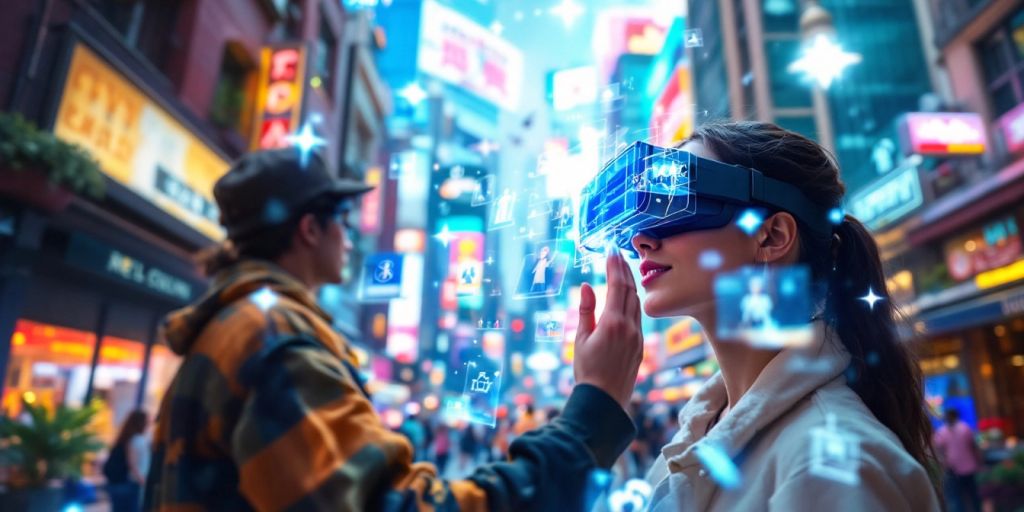Artificial Intelligence
Augmented Reality Innovation: Bridging the Gap Between Real and Virtual

Augmented Reality (AR) is changing how we see and interact with the world around us. It combines real life with digital elements, making our experiences richer and more engaging. In this article, we will look at the journey of AR, how it improves user experiences, and its future potential in various fields.
Key Takeaways
- AR blends the real and digital worlds, enhancing our everyday experiences.
- It is used in many areas, including education, healthcare, and retail.
- AR technology is evolving, with new tools and applications emerging regularly.
- Despite its benefits, AR faces challenges like technical issues and privacy concerns.
- The future of AR looks bright, with potential for further integration into our daily lives.
The Evolution of Augmented Reality (AR) Innovation

Early Beginnings and Milestones
Augmented Reality (AR) has come a long way since its inception. It started as a simple concept in the 1960s with the invention of the first head-mounted display. Over the years, several key milestones have shaped its development:
- 1968: Ivan Sutherland creates the first head-mounted display.
- 1990: The term "augmented reality" is coined by Tom Caudell.
- 2000: ARToolKit, an open-source software library, is released.
Technological Advancements
The growth of AR has been driven by significant technological advancements. These include:
- Improved hardware: The rise of smartphones and tablets has made AR more accessible.
- 5G technology: This enhances user experiences by enabling faster data transfer, allowing for more complex AR applications.
- Mixed Reality (MR): Combining AR and VR, MR is set to revolutionise industries by providing immersive experiences.
Current Trends in AR
Today, AR is transforming various sectors. Some notable trends include:
- Gaming: Games like Pokémon GO have popularised AR, blending real-world exploration with virtual elements.
- Retail: Virtual try-ons and product visualisation are enhancing the shopping experience.
- Education: Interactive learning tools are making education more engaging and effective.
The evolution of AR is not just about technology; it’s about how we interact with the world around us. As AR continues to develop, it will reshape our experiences in ways we are just beginning to understand.
How Augmented Reality (AR) Enhances User Experience
Immersive Gaming Experiences
Augmented Reality (AR) has transformed gaming by creating immersive experiences that blend the real world with virtual elements. Games like Pokémon GO allow players to explore their surroundings while interacting with digital creatures. This fusion of reality and fantasy not only enhances gameplay but also encourages physical activity and social interaction.
Interactive Educational Tools
In education, AR makes learning more engaging. Students can interact with 3D models and simulations, bringing subjects to life. For example:
- Science: Visualise complex biological processes.
- History: Experience historical events in real-time.
- Mathematics: Manipulate geometric shapes in a virtual space.
These tools help students grasp difficult concepts more easily and retain information better.
Enhanced Shopping and Retail
AR is revolutionising the shopping experience. Customers can virtually try on clothes or see how furniture looks in their homes before buying. This technology not only improves customer satisfaction but also reduces return rates. Here’s a quick overview of its benefits:
| Benefit | Description |
|---|---|
| Visualisation | See products in real-world settings. |
| Convenience | Shop from anywhere with AR apps. |
| Informed Decisions | Make better choices with virtual try-ons. |
Augmented Reality is not just a trend; it’s a game-changer in how we interact with the world around us. By enhancing user experiences across various sectors, AR is paving the way for a more connected and interactive future.
Augmented Reality (AR) in Healthcare

Surgical Assistance and Training
Augmented Reality is changing the way surgeries are performed. Surgeons can now use AR to overlay digital images onto the real world, helping them see critical information during operations. This technology allows for better precision and improved outcomes.
Some key benefits include:
- Enhanced visualisation of anatomy
- Real-time data during procedures
- Reduced risk of errors
Patient Education and Rehabilitation
AR is also beneficial for educating patients about their conditions. By using AR, patients can see 3D models of their anatomy, which helps them understand their treatment better. This leads to:
- Increased patient engagement
- Better understanding of medical procedures
- Improved rehabilitation through interactive exercises
Medical Imaging and Visualisation
In medical imaging, AR allows doctors to view scans in a more interactive way. This technology helps in diagnosing conditions more accurately. For example, AR can:
- Overlay MRI or CT scans onto the patient’s body
- Provide a clearer view of complex structures
- Assist in planning surgeries with precision
Augmented Reality is not just a tool; it’s a revolution in healthcare, making procedures safer and more effective.
| Application | Benefits |
|---|---|
| Surgical Assistance | Improved precision and outcomes |
| Patient Education | Enhanced understanding and engagement |
| Medical Imaging | Accurate diagnosis and planning |
The Role of Augmented Reality (AR) in Education
Interactive Learning Modules
Augmented Reality (AR) is changing how students learn by making lessons more engaging. With AR, students can interact with 3D models and visualise complex ideas. For example, in a science class, students can see a virtual model of the solar system, allowing them to explore planets up close. This hands-on approach helps deepen understanding.
Virtual Field Trips
AR allows students to take virtual field trips without leaving the classroom. They can visit historical sites, museums, or even outer space through their devices. This technology makes learning exciting and accessible, especially for those who may not have the chance to travel. Here are some benefits of virtual field trips:
- Cost-effective: No travel expenses involved.
- Safe exploration: Students can learn about different cultures and places without risks.
- Interactive experiences: Engaging content keeps students interested.
Hands-On Training Simulations
In subjects like medicine or engineering, AR provides realistic training simulations. Students can practise procedures in a safe environment, gaining valuable skills before working with real patients or equipment. This method enhances learning by allowing students to:
- Practise repeatedly without fear of making mistakes.
- Receive instant feedback on their performance.
- Build confidence in their abilities.
Augmented Reality is not just a tool; it’s a bridge to a more interactive and engaging educational experience. It transforms traditional learning into an exciting adventure.
AR is paving the way for a new era in education, making learning more effective and enjoyable for everyone.
Augmented Reality (AR) in Retail and E-commerce
Augmented Reality (AR) is changing the way we shop, making it more exciting and interactive. With AR, customers can try on clothes and accessories virtually, which helps them make better choices before buying. This technology is not just about fun; it also helps businesses reduce returns and improve customer satisfaction.
Virtual Try-Ons
- Customers can see how clothes fit without trying them on physically.
- Makeup brands allow users to see how products look on their skin.
- Footwear companies let shoppers check how shoes look on their feet.
Product Visualisation
- AR helps customers see how furniture will look in their homes before purchasing.
- Shoppers can view products in 3D, giving them a better idea of size and design.
- This technology allows for a more informed decision-making process.
Enhanced Customer Engagement
- Retailers can create interactive experiences that attract more customers.
- AR can be used in marketing campaigns to engage users in new ways.
- Customers are more likely to share their AR experiences on social media, increasing brand visibility.
In the world of retail, AR is not just a trend; it’s a powerful tool that enhances the shopping experience and bridges the gap between the real and virtual worlds.
As we look at the future, the potential for AR in retail and e-commerce is vast, promising a more engaging and efficient shopping experience for everyone.
Technologies Powering Augmented Reality (AR) Innovation
AR Hardware and Devices
The backbone of augmented reality lies in its hardware. Key devices include:
- Smartphones: Most accessible AR platform.
- AR Glasses: Wearable tech that overlays digital content.
- Headsets: Provide immersive experiences for gaming and training.
Software and Development Tools
To create AR experiences, developers rely on various software tools. Some popular ones are:
- Unity: A game engine widely used for AR applications.
- ARKit and ARCore: Platforms for building AR apps on iOS and Android.
- Vuforia: A tool for creating marker-based AR experiences.
Integration with Other Technologies
AR does not work in isolation; it often integrates with other technologies to enhance its capabilities. This includes:
- Artificial Intelligence: For smarter interactions and object recognition.
- 5G Connectivity: Enables faster data transfer for real-time experiences.
- Cloud Computing: Supports heavy processing and storage needs.
The combination of these technologies is what makes AR experiences truly engaging and interactive. As we continue to innovate, the potential for AR will only grow, bridging the gap between the real and virtual worlds.
| Technology Type | Examples | Purpose |
|---|---|---|
| AR Hardware | Smartphones, AR Glasses | Displaying AR content |
| Software Tools | Unity, ARKit, Vuforia | Developing AR applications |
| Integration Technologies | AI, 5G, Cloud Computing | Enhancing AR functionality and performance |
Challenges and Limitations of Augmented Reality (AR)
Augmented Reality (AR) is a fascinating technology, but it faces several significant challenges that can hinder its growth and adoption. Understanding these limitations is crucial for developers and users alike.
Technical Hurdles
- Hardware Limitations: Many devices lack the necessary power to run advanced AR applications smoothly.
- Software Compatibility: Not all software is designed to work with AR, leading to potential issues in user experience.
- Network Dependence: AR often requires a stable internet connection, which can be a barrier in areas with poor connectivity.
User Adoption and Accessibility
- Learning Curve: Users may find it difficult to adapt to new AR technologies, which can slow down adoption rates.
- Cost of Devices: High-quality AR devices can be expensive, making them less accessible to the average consumer.
- Limited Awareness: Many people are still unaware of what AR can do, which limits its potential user base.
Privacy and Security Concerns
- Data Collection: AR applications often collect personal data, raising concerns about privacy.
- Security Risks: Vulnerabilities in AR software can lead to security breaches, putting user data at risk.
- Ethical Issues: The use of AR in public spaces can lead to ethical dilemmas regarding surveillance and consent.
The future of AR is bright, but addressing these challenges is essential for its widespread acceptance and success. By overcoming these hurdles, we can unlock the full potential of this innovative technology.
| Challenge Type | Description |
|---|---|
| Technical Hurdles | Issues related to hardware and software compatibility. |
| User Adoption and Accessibility | Barriers that prevent users from fully embracing AR technology. |
| Privacy and Security Concerns | Risks associated with data collection and ethical use of AR. |
By tackling these challenges, the AR industry can pave the way for a more integrated and user-friendly experience, ultimately bridging the gap between the real and virtual worlds.
Future Prospects of Augmented Reality (AR) Innovation
Upcoming Technological Developments
The future of AR is bright, with exciting advancements on the horizon. Here are some key areas to watch:
- Holographic Displays: These will allow users to interact with 3D images in real space.
- Wearable Devices: Smart glasses and contact lenses will integrate AR into daily life.
- AI Integration: Combining AR with artificial intelligence will enhance user experiences.
Potential Industry Disruptions
AR is set to change various sectors significantly. Some potential disruptions include:
- Retail: Virtual try-ons will become standard, reducing return rates.
- Healthcare: Surgeons will use AR for training and real-time assistance during operations.
- Education: Interactive learning will become more immersive, making lessons more engaging.
Long-Term Vision for AR
The ultimate goal of AR is to seamlessly blend the real and virtual worlds. This vision includes:
- Enhanced Social Interactions: AR will change how we connect with others.
- Smart Environments: Our surroundings will respond to our needs through AR.
- Personalised Experiences: Tailored content will be delivered based on individual preferences.
The future of AR is not just about technology; it’s about creating a world where the real and virtual coexist harmoniously, enriching our lives in countless ways.
As we look ahead, the potential for AR to transform our daily experiences is immense, making it an exciting field to watch.
Augmented Reality (AR) in Entertainment and Media
AR in Gaming
Augmented Reality has transformed the gaming landscape, creating immersive experiences that blend the real and virtual worlds. Games like Pokémon GO have captivated millions, allowing players to hunt for virtual creatures in their actual surroundings. This innovative approach has not only made gaming more engaging but has also encouraged players to explore their environments.
Interactive Storytelling
AR is revolutionising storytelling by making it interactive. Readers can engage with characters and settings in a way that traditional media cannot offer. For instance, books and comics can come to life with animations and 3D models, providing a richer narrative experience. This fusion of technology and storytelling enhances emotional connections and keeps audiences captivated.
Live Events and Performances
In the realm of live events, AR is enhancing audience engagement. Concerts and performances can incorporate real-time visual effects, creating a more dynamic atmosphere. Attendees can use their devices to see additional layers of content, such as behind-the-scenes footage or interactive elements that complement the live show. This not only enriches the experience but also creates memorable moments for the audience.
Summary of AR Applications in Entertainment
| Application Type | Description |
|---|---|
| Gaming | Blends real-world exploration with virtual gameplay. |
| Storytelling | Makes narratives interactive and engaging. |
| Live Events | Enhances performances with real-time visuals. |
Augmented Reality is not just a trend; it’s a game-changer in how we experience entertainment. By merging the real and virtual worlds, AR opens up new avenues for creativity and engagement.
Augmented Reality (AR) for Industrial Applications
Manufacturing and Maintenance
Augmented Reality is changing the way industries operate, especially in manufacturing and maintenance. AR provides real-time instructions that help workers perform tasks more efficiently. Here are some key benefits:
- Improved Accuracy: Workers can overlay digital schematics onto physical equipment, reducing errors.
- Enhanced Training: New employees can learn on the job with interactive guides, making training faster and more effective.
- Remote Assistance: Experts can assist on-site workers through AR, providing guidance without being physically present.
Remote Assistance and Training
AR is also pivotal in remote assistance and training. It allows experts to guide technicians through complex repairs or installations from afar. This is particularly useful in:
- Real-time Problem Solving: Experts can see what the technician sees and provide immediate feedback.
- Cost Reduction: Fewer travel expenses for experts, as they can assist remotely.
- Faster Resolution Times: Issues can be resolved more quickly, minimising downtime.
Design and Prototyping
In design and prototyping, AR enables teams to visualise products before they are built. This leads to:
- Faster Iteration: Designers can make changes on the fly, saving time and resources.
- Better Collaboration: Teams can work together in a shared AR space, regardless of their physical location.
- Enhanced Client Presentations: Clients can see a 3D model of the product in their environment, improving understanding and feedback.
Augmented Reality is not just a tool; it’s a game-changer in industrial applications, bridging the gap between the real and virtual worlds. By integrating AR into their processes, industries can enhance productivity and innovation.
The Impact of Augmented Reality (AR) on Social Interaction
Augmented Social Media
Augmented Reality is changing how we connect on social media. With AR philtres and effects, users can enhance their photos and videos, making interactions more fun and engaging. This technology allows for creative expression and helps users stand out in a crowded digital space.
Collaborative AR Experiences
AR enables groups to share experiences in real-time, regardless of their physical location. For instance, friends can play AR games together or collaborate on projects using AR tools. This fosters a sense of community and connection, even when people are apart.
Virtual Meetups and Events
With AR, virtual events can feel more immersive. Attendees can interact with 3D objects and environments, making online gatherings more engaging. This technology can transform how we attend concerts, conferences, and social events, creating memorable experiences.
Augmented Reality is not just about technology; it’s about enhancing our connections with others.
Summary of AR’s Impact on Social Interaction
| Aspect | Description |
|---|---|
| Social Media | Enhances user creativity with philtres and effects. |
| Collaboration | Enables real-time shared experiences, fostering community. |
| Virtual Events | Makes online gatherings more immersive and engaging. |
Augmented Reality (AR) and Mixed Reality (MR) Fusion
Defining Mixed Reality
Mixed Reality (MR) is a blend of both Augmented Reality and Virtual Reality, allowing users to interact with virtual objects as if they were part of the real world. This technology creates a seamless experience where digital elements are integrated into the physical environment, enhancing user interaction.
Applications of MR in AR
The fusion of AR and MR has significant implications across various sectors:
- Retail and Marketing: Customers can visualise products in their own space before purchasing.
- Education and Training: Interactive simulations make learning more engaging and effective.
- Healthcare: MR aids in surgical training and patient rehabilitation, providing innovative solutions.
Future of AR and MR Integration
The future looks promising as AR continues to evolve, incorporating MR capabilities. This integration will lead to:
- More immersive experiences in gaming and entertainment.
- Enhanced training tools in various industries.
- Improved customer engagement in retail.
The merging of AR and MR is not just a technological advancement; it’s a revolution in how we perceive and interact with our surroundings.
In conclusion, the fusion of Augmented Reality and Mixed Reality is paving the way for a new era of interaction, where the lines between the real and virtual worlds are increasingly blurred, creating endless possibilities for innovation and engagement.
Conclusion
In summary, augmented reality (AR) is changing how we see and engage with the world around us. By merging the real and virtual realms, AR opens up exciting new possibilities across many fields, from shopping to education. This technology not only makes experiences more enjoyable but also helps us learn and connect in ways we never thought possible. As we continue to explore AR, we are just beginning to understand its full potential, paving the way for a future where the lines between reality and the digital world are beautifully blurred.
Frequently Asked Questions
What is Augmented Reality (AR)?
Augmented Reality (AR) is a technology that adds digital elements to the real world. It enhances what you see around you by overlaying computer-generated images or information.
How does AR differ from Virtual Reality (VR)?
AR adds digital content to the real world, while VR creates a completely virtual environment that replaces the real world.
What are some common uses of AR?
AR is used in various fields like gaming, education, healthcare, and shopping. For example, you can try on clothes virtually, learn anatomy with 3D models, or play games that mix real and virtual elements.
What devices can run AR applications?
You can use smartphones, tablets, and special glasses or headsets to access AR applications.
Is AR safe to use?
Generally, AR is safe, but it’s important to be cautious about privacy and security, especially when sharing personal information.
Can AR be used in education?
Yes, AR makes learning more engaging by providing interactive experiences, such as visualising historical events or exploring scientific concepts.
What are the challenges of using AR?
Some challenges include technical issues, user acceptance, and concerns about privacy and security.
What does the future hold for AR?
The future of AR looks bright, with ongoing advancements expected to enhance its applications in various fields, making it more integrated into our daily lives.
-

 Business6 days ago
Business6 days agoS&P 500 Soars in Best May in Decades Amid Tariff Relief and Nvidia’s Surge
-

 Immigration6 days ago
Immigration6 days agoTrump’s Immigration Crackdown: Legal Battles and Policy Shifts
-

 Business6 days ago
Business6 days agoUS Stock Market Soars in May Amidst Tariff Tensions and Inflation Worries
-

 Government6 days ago
Government6 days agoTrump Administration’s Government Reshaping Efforts Face Criticism and Legal Battles
-

 Business6 days ago
Business6 days agoTrump’s Tariffs: A Global Economic Reckoning
-

 Foreign Policy4 days ago
Foreign Policy4 days agoInside Schedule F: Will Trump’s Federal Workforce Shake-Up Undermine Democracy?
-

 Press Release3 days ago
Press Release3 days agoIn2space Launches Campaign to Make Space Travel Accessible for All













